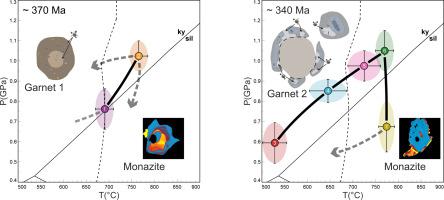当前位置:
X-MOL 学术
›
Gondwana Res.
›
论文详情
Our official English website, www.x-mol.net, welcomes your feedback! (Note: you will need to create a separate account there.)
Two generations of Variscan garnet: Implications from a petrochronological study of a high-grade Avalonia-derived paragneiss from the Drosendorf unit, Bohemian Massif
Gondwana Research ( IF 6.1 ) Pub Date : 2020-09-01 , DOI: 10.1016/j.gr.2020.04.004 Dominik Sorger , Christoph A. Hauzenberger , Fritz Finger , Manfred Linner
Gondwana Research ( IF 6.1 ) Pub Date : 2020-09-01 , DOI: 10.1016/j.gr.2020.04.004 Dominik Sorger , Christoph A. Hauzenberger , Fritz Finger , Manfred Linner

|
Abstract Garnets in metapelitic paragneisses from the southern Drosendorf unit in the Austrian part of the Bohemian Massif exhibit two episodes of growth during the Variscan orogeny, which can be distinguished on textural and chemical grounds. The first garnet (grt1) records evidence of high-grade metamorphism in the Late Devonian (Frasnian–Famennian), while the second garnet (grt2) formed by a second high-grade event in the Early Carboniferous (Visean). Both garnet generations contain abundant inclusions, of which monazite, rutile and crystallised melt droplets are particularly useful for reconstructing P–T–t conditions. The Late Devonian age (373 ± 9 Ma) for the first episode of garnet growth was obtained from chemical dating of monazite inclusions in grt1. Metamorphic conditions during the first episode of garnet growth are estimated to have been between 0.7 and 0.8 GPa at 680–700 °C and 0.95–1.10 GPa at 745–785 °C. There followed a phase of cooling and exhumation, after which the second garnet (grt2) were formed beginning under amphibolite facies conditions and continuing prograde to peak conditions of 0.95–1.10 GPa and 745–785 °C, which are similar to those of the first garnet forming event. Subsequently, the rocks experienced near isothermal decompression to 0.5–0.8 GPa. Chemical dating of both monazite inclusions in grt2 and the matrix provide a Visean age (343 ± 3 Ma). A study of detrital zircons in these paragneisses revealed zircon forming events at around 1.2, 1.5 and 1.8 Ga, suggesting an Avalonian provenance. The lack of zircons younger than 1 Ga and the presence of Cadomian metamorphic monazite relics (652 ± 15 Ma) indicates an Early Neoproterozoic deposition age for the sedimentary protolith likely. Our documentation of a Late Devonian high-grade metamorphic event in rocks derived from Avalonian corroborates tectonic models which assume that frontal parts of the Armorican terrane had already docked with Avalonia by this time.
中文翻译:

两代 Variscan 石榴石:来自波希米亚地块 Drosendorf 单元的高级 Avalonia 副片麻岩的岩石年代学研究的意义
摘要 波西米亚地块奥地利部分德罗森多夫单元南部的变泥质副片麻岩中的石榴石在 Variscan 造山运动期间表现出两次生长,可以从质地和化学方面加以区分。第一颗石榴石 (grt1) 记录了晚泥盆世 (Frasnian-Famennian) 高等级变质作用的证据,而第二颗石榴石 (grt2) 则由早石炭世 (Visean) 的第二次高等级事件形成。两代石榴石都含有丰富的内含物,其中独居石、金红石和结晶熔滴对于重建 P-T-t 条件特别有用。石榴石生长第一阶段的晚泥盆世年龄(373±9 Ma)是从 grt1 中独居石包裹体的化学定年获得的。石榴石生长第一阶段的变质条件估计在 680-700°C 时为 0.7-0.8 GPa,在 745-785°C 时为 0.95-1.10 GPa。随后是冷却和折返阶段,此后在角闪岩相条件下开始形成第二颗石榴石 (grt2),并继续前进到 0.95-1.10 GPa 和 745-785 °C 的峰值条件,这与第一颗石榴石相类似石榴石形成事件。随后,岩石经历了接近 0.5-0.8 GPa 的等温减压。grt2 中的独居石包裹体和基质的化学定年提供了维氏年龄 (343 ± 3 Ma)。对这些副片麻岩中碎屑锆石的研究揭示了大约 1.2、1.5 和 1.8 Ga 的锆石形成事件,表明它是阿瓦隆阶的出处。缺乏小于 1 Ga 的锆石和 Cadomian 变质独居石遗迹 (652 ± 15 Ma) 的存在表明沉积原岩可能为早新元古代沉积时代。我们对源自阿瓦隆阶的岩石中晚泥盆世高等级变质事件的记录证实了构造模型,该模型假设此时 Armorican 地体的正面部分已经与阿瓦隆尼亚对接。
更新日期:2020-09-01
中文翻译:

两代 Variscan 石榴石:来自波希米亚地块 Drosendorf 单元的高级 Avalonia 副片麻岩的岩石年代学研究的意义
摘要 波西米亚地块奥地利部分德罗森多夫单元南部的变泥质副片麻岩中的石榴石在 Variscan 造山运动期间表现出两次生长,可以从质地和化学方面加以区分。第一颗石榴石 (grt1) 记录了晚泥盆世 (Frasnian-Famennian) 高等级变质作用的证据,而第二颗石榴石 (grt2) 则由早石炭世 (Visean) 的第二次高等级事件形成。两代石榴石都含有丰富的内含物,其中独居石、金红石和结晶熔滴对于重建 P-T-t 条件特别有用。石榴石生长第一阶段的晚泥盆世年龄(373±9 Ma)是从 grt1 中独居石包裹体的化学定年获得的。石榴石生长第一阶段的变质条件估计在 680-700°C 时为 0.7-0.8 GPa,在 745-785°C 时为 0.95-1.10 GPa。随后是冷却和折返阶段,此后在角闪岩相条件下开始形成第二颗石榴石 (grt2),并继续前进到 0.95-1.10 GPa 和 745-785 °C 的峰值条件,这与第一颗石榴石相类似石榴石形成事件。随后,岩石经历了接近 0.5-0.8 GPa 的等温减压。grt2 中的独居石包裹体和基质的化学定年提供了维氏年龄 (343 ± 3 Ma)。对这些副片麻岩中碎屑锆石的研究揭示了大约 1.2、1.5 和 1.8 Ga 的锆石形成事件,表明它是阿瓦隆阶的出处。缺乏小于 1 Ga 的锆石和 Cadomian 变质独居石遗迹 (652 ± 15 Ma) 的存在表明沉积原岩可能为早新元古代沉积时代。我们对源自阿瓦隆阶的岩石中晚泥盆世高等级变质事件的记录证实了构造模型,该模型假设此时 Armorican 地体的正面部分已经与阿瓦隆尼亚对接。


























 京公网安备 11010802027423号
京公网安备 11010802027423号